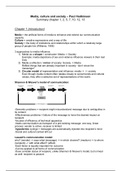Samenvatting
Media, Culture and Society summary - chapter 1, 2, 5, 7, 10, 12, 13
- Instelling
- Rijksuniversiteit Groningen (RuG)
-Samenvatting Media Culture and Society van Paul Hodkinson (2e editie) van de hoofdstukken 1, 2, 5, 7, 10, 12 en 13. -Gemaakt voor het gelijknamige vak van het 1e jaar van Media Studies aan de Rijksuniversiteit Groningen. -Overzichtelijke samenvatting met de belangrijkste punten, uitleg en voorbee...
[Meer zien]





